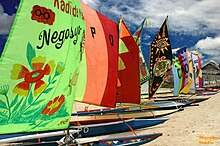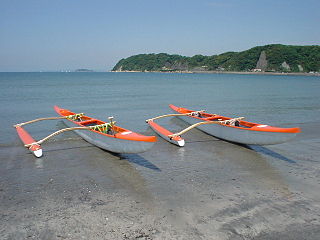
Outrigger boats are various watercraft featuring one or more lateral support floats known as outriggers, which are fastened to one or both sides of the main hull. They can range from small dugout canoes to large plank-built vessels. Outrigger boats can also vary in their configuration, from the ancestral double-hull configuration (catamarans), to single-outrigger vessels prevalent in the Pacific Islands and Madagascar, to the double-outrigger vessels (trimarans) prevalent in Island Southeast Asia. They are traditionally fitted with Austronesian sails, like the crab claw sails and tanja sails, but in modern times are often fitted with petrol engines.

Proas are various types of multi-hull outrigger sailboats of the Austronesian peoples. The terms were used for native Austronesian ships in European records during the Colonial era indiscriminately, and thus can confusingly refer to the double-ended single-outrigger boats of Oceania, the double-outrigger boats of Island Southeast Asia, and sometimes ships with no outriggers or sails at all.

A pump boat is an outrigger canoe powered by a small gasoline or diesel engine. Smaller pump boats might be powered by the sort of small single-cylinder engine used to drive a water pump. Larger ones are often powered by recycled automobile engines.
Canoe sailing refers to the practice of fitting an Austronesian outrigger or Western canoe with sails.

The Sama-Bajau include several Austronesian ethnic groups of Maritime Southeast Asia. The name collectively refers to related people who usually call themselves the Sama or Samah ; or are known by the exonym Bajau. They usually live a seaborne lifestyle and use small wooden sailing vessels such as the perahu, djenging (balutu), lepa, and vinta (pilang). Some Sama-Bajau groups native to Sabah are also known for their traditional horse culture.

The vinta is a traditional outrigger boat from the Philippine island of Mindanao. The boats are made by Sama-Bajau, Tausug and Yakan peoples living in the Sulu Archipelago, Zamboanga peninsula, and southern Mindanao. Vinta are characterized by their colorful rectangular lug sails (bukay) and bifurcated prows and sterns, which resemble the gaping mouth of a crocodile. Vinta are used as fishing vessels, cargo ships, and houseboats. Smaller undecorated versions of the vinta used for fishing are known as tondaan.

Paraw are various double outrigger sail boats in the Philippines. It is a general term and thus can refer to a range of ship types, from small fishing canoes to large merchant lashed-lug plank boats with two outriggers (katig) propelled by sails
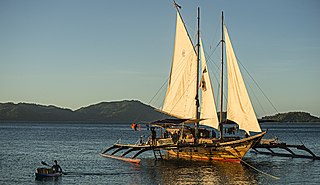
A balangay, or barangay, is a type of lashed-lug boat built by joining planks edge-to-edge using pins, dowels, and fiber lashings. They are found throughout the Philippines and were used largely as trading ships up until the colonial era. The oldest known balangay are the Butuan boats, which have been carbon-dated to 320 AD and were recovered from several sites in Butuan, Agusan del Norte.

Karakoa were large outrigger warships from the Philippines. They were used by native Filipinos, notably the Kapampangans and the Visayans, during seasonal sea raids. Karakoa were distinct from other traditional Philippine sailing vessels in that they were equipped with platforms for transporting warriors and for fighting at sea. During peacetime, they were also used as trading ships. Large karakoa, which could carry hundreds of rowers and warriors, were known as joangas by the Spanish.

Lanong were large outrigger warships used by the Iranun and the Banguingui people of the Philippines. They could reach up to 30 m (98 ft) in length and had two biped shear masts which doubled as boarding ladders. They also had one to three banks of oars rowed by galley slaves. They were specialized for naval battles. They were prominently used for piracy and slave raids from the mid-18th century to the early 19th century in most of Southeast Asia. The name lanong is derived from Lanun, an exonym of the Iranun people.
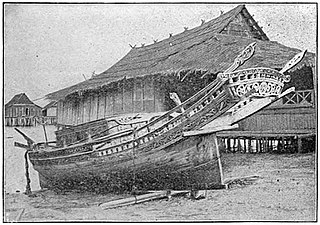
Lepa, also known as lipa or lepa-lepa, are indigenous ships of the Sama-Bajau people in Indonesia, the Philippines, and Malaysia. They were traditionally used as houseboats by the seagoing Sama Dilaut. Since most Sama have abandoned exclusive sea-living, modern lepa are instead used as fishing boats and cargo vessels.

Buggoh is a type of small dugout canoe of the Sama-Bajau people of the Philippines. They are made from a single log hollowed into a canoe with a rounded bottom. It is equal-ended, with the prow and the stern dropping straight down or sloping outward. They are sometimes equipped with two outrigger floats. They are usually around 1.5 to 4.5 m long. It is also known by various other names, including boggo', buggoh jungalan, buggoh-buggoh, or beggong.
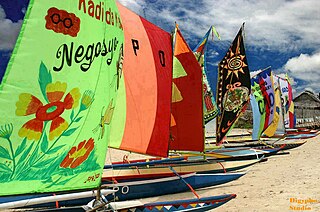
Bigiw is a small double-outrigger sailboat native to the islands of Mindanao, Visayas, and Palawan in the Philippines. It is used for personal transport or small-scale fishing and can hold one to three people. It is traditionally propelled by sails and steered with a single oar, but is commonly motorized in modern times. It can also be paddled. The sail type used is predominantly triangular crab claw sails, but it can also use spritsails or tanja sails.
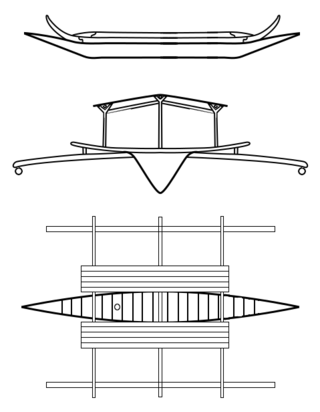
Djenging is a type of large double-outrigger plank boat built by the Sama-Bajau people of the Philippines. It is typically used as a houseboat, though it can be converted to a sailing ship. It was the original type of houseboat used by the Sama-Bajau before it was largely replaced by the lepa after World War II. Larger versions of djenging were also known as balutu or kubu, often elaborately carved with bifurcated extensions on the prow and stern.

Birau, is a type of small dugout canoe of the Sama-Bajau people of the Philippines. They are made from a single log hollowed into a canoe with a rounded bottom. The prow and stern of the vessel usually has knob-like protrusions. A smaller wider variant without these knobs is known as bitok. Birau are usually around 1.5 to 4.5 m long. They are sometimes equipped with two outrigger floats. They are very similar to the buggoh, differing only in that the prow and the stern of the birau slope inward.

Junkun, is a type of small dugout canoe of the Sama-Bajau people of the Philippines. They are usually made from a single log, though a single plank can be added to the sides, and longer boats can include ribs that support a deck made of planks. They are around 2.5 to 8 m long. They have knob-like protrusions on the tip of the prow and the stern, which also sweep upwards from the waterline. They are sometimes equipped with double outriggers. They are used for fishing and short-distance travel.
Bangka anak-anak are very small dugout canoes among the Sama-Bajau people of the Philippines. They are typically made by Sama-Bajau fathers for their children and are patterned after the larger Sama-Bajau dugout canoes. They can be used for transportation between the Sama-Bajau houseboats, but are more commonly used for playing. They are typically no longer than around 1.5 m (4.9 ft) long. Children as young as three or four can use these boats, which allows them to learn valuable maritime skills.
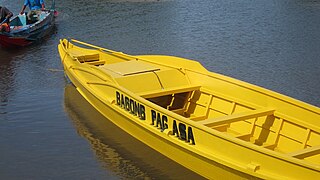
Tiririt, also known as taririt or papet, is a type of small dinghy of the Sama-Bajau and Tausug people of the Philippines. It is commonly motorized. It is usually carried aboard larger motherships and assists in transporting passenger and cargo to the shore, as well as in towing the boat to port. However, it can also be used as a small inter-island transport. It is roughly leaf-shaped in outline with a distinctive hump-backed side-profile. The prow and stern can sometimes rise up into arcs. It normally has no outriggers.
Junkung, also spelled jungkung or jungkong, is a small wooden motorized boat used by Tausug, Sama-Bajau, and Yakan people of the Philippines. It is a fast cargo ship and is commonly used as a smuggling vessel in the maritime borders of the Philippines, Sabah, Malaysia and Eastern Indonesia. They are also sometimes used by pirates and Abu Sayyaf terrorists in and around the Sulu Sea.

Austronesian vessels are the traditional seafaring vessels of the Austronesian peoples of Taiwan, Maritime Southeast Asia, Micronesia, coastal New Guinea, Island Melanesia, Polynesia, and Madagascar. They also include indigenous ethnic minorities in Vietnam, Cambodia, Myanmar, Thailand, Hainan, the Comoros, and the Torres Strait Islands.







